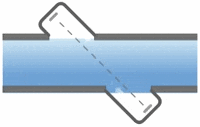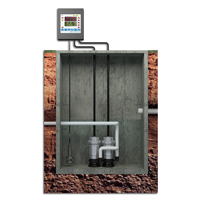 Ultrasonic flowmeters use sound waves to determine the velocity of a fluid flowing in a pipe. At no flow conditions, the frequencies of an ultrasonic wave transmitted into a pipe and its reflections from the fluid are the same. Under flowing conditions, the frequency of the reflected wave is different due to the Doppler effect. When the fluid moves faster, the frequency shift increases linearly. The transmitter processes signals from the transmitted wave and its reflections to determine the flow rate. Continue reading “How Ultrasonic Flowmeters Work”
Ultrasonic flowmeters use sound waves to determine the velocity of a fluid flowing in a pipe. At no flow conditions, the frequencies of an ultrasonic wave transmitted into a pipe and its reflections from the fluid are the same. Under flowing conditions, the frequency of the reflected wave is different due to the Doppler effect. When the fluid moves faster, the frequency shift increases linearly. The transmitter processes signals from the transmitted wave and its reflections to determine the flow rate. Continue reading “How Ultrasonic Flowmeters Work”
Lift Station Level Sensing
Are you having problems with your current lift station level controls? Dwyer Instruments may just have the cost effective solution you need. In this article we will review several level sensing strategies, the advantages and disadvantages of each, as well as an option you may want to consider for your next project.
Lift Station Basics
 In an ideal gravity fed wastewater collection system, sewage would flow downhill from its point of origin in residential or commercial areas to its final treatment plant destination. Due to a number of factors including total distance, topography, geology, economics, etc., the ideal piping design is not always feasible. Therefore, in most cases, sewage flows downhill to a lift station where it collects and then is pumped to a higher elevation in order to begin its downhill journey again. Continue reading “Lift Station Level Sensing”
In an ideal gravity fed wastewater collection system, sewage would flow downhill from its point of origin in residential or commercial areas to its final treatment plant destination. Due to a number of factors including total distance, topography, geology, economics, etc., the ideal piping design is not always feasible. Therefore, in most cases, sewage flows downhill to a lift station where it collects and then is pumped to a higher elevation in order to begin its downhill journey again. Continue reading “Lift Station Level Sensing”
